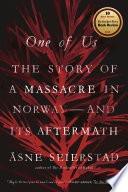One of Us: The Story of Anders Breivik and the Massacre in Norway is an enormous book that examines the life of the Islamophobic and misogynistic terrorist and his victims. One of Us: The Story of Anders Breivik and the Massacre in Norway is a masterpiece in its comprehensive scope of those lives from childhood to trial. The most tragic aspect of Breivik’s life is that Norway’s social welfare system flagged him as having developmental problems possibly caused by neglect or psychological abuse as a child, and tried to get his mother to give him to a more attentive couple, but when his father suddenly appeared after years of no involvement to get custody, she wanted to retain custody. Once she did that, the father soon lost interest, and one can infer that his home situation did not improve. Does that explain or excuse his mass murder? Not in the least, but it certainly was a factor. If I had to critique One of Us: The Story of Anders Breivik and the Massacre in Norway, it is that every action, no matter how insignificant or significant, is retroactively imbued with meaning because of Breivik’s madness. Everyone wants to feel special, important or talented, but falls short of reality and gets no respect at one point or another. Many people never find love or the thing that makes them special. Not everyone turns to forgery and plagiarism, then randomly escalates to violent right-wing fantasies of uprisings against his government. The only thing that Breivik ever worked hard and succeeded at was killing people. The stories of his victims, mainly children, is heartbreakingly devastating, especially considering how different they were from Breivik: conscientious, personable, effective. Some of these children escaped Iraq as refugees. Breivik succeeded at killing the best and brightest of the left wing’s future.
One of Us: The Story of Anders Breivik and the Massacre in Norway also gives important lessons of how the Norwegian government failed to adequately respond to a one-man terrorist. Security measures around the prime minister’s office were not enforced. Even though there were emergency measures in place, they were not implemented. His identity was not communicated even though eyewitnesses reported him to the police. When proper communication channels were used, they were not monitored or seen until long after the emergency ended. The local police had no idea how to approach the location where the children were camped and got lost. Basically even officials panic during emergencies, and no one is prepared for the worst-case scenario. I can’t imagine how authorities react when they are afraid and find the victims less relatable.
For me, the most frightening aspect of One of Us: The Story of Anders Breivik and the Massacre in Norway is the fact that my library copy was pristine, but a prior reader resonated with four insane quotes by Breivik given at trial and signaled it with a blue felt tip pen check mark. I live in Massachusetts, an alleged bastion of liberalism and academia. In US, mass shootings are like bad weather-someone somewhere is experiencing it. At least in Norway, they only have one dangerous guy with a gun.

One of Us: The Story of Anders Breivik and the Massacre in Norway
Stay In The Know
Join my mailing list to get updates about recent reviews, upcoming speaking engagements, and film news.




